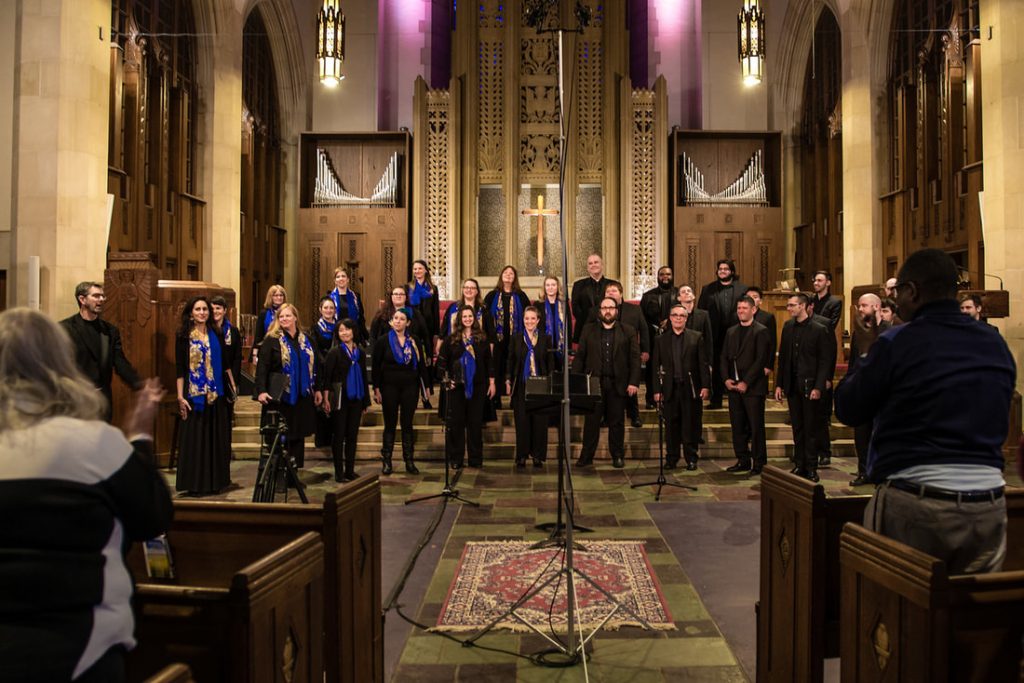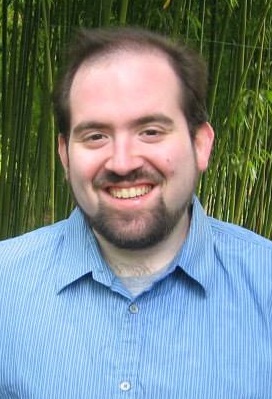by Jarrett Hoffman

The other thread comes in the form of arrangements. That art form is all about old and new, but the emphasis is on the latter here: Hanukkah tunes arranged by Andrew Rindfleisch and Corey K. Rubin will receive their world premieres.
Performances take place on Saturday, December 7 at 7:30 pm at Lakewood Congregational Church, and on Sunday, December 8 at 3:00 pm at First Baptist Church of Greater Cleveland. Charles McGuire will talk about the program 45 minutes before both concerts. Tickets are available online.
Cleveland Chamber Choir has performed several of Rubin’s works over the years, including his Euclid Avenue Songs on their debut concert in 2015. This year’s Hanukkah arrangement is his third commission from the group.
“It’s extra special for me because I am a member of the choir,” Rubin said, comparing the group to a family. “It’s full of people that I’ve known for a long time. When I was still in grad school in Indiana, I was always following their concerts from afar and wishing that I could be singing with them.”

The story of this latest commission from the Choir began when MacPherson asked Rubin to contribute a Hanukkah arrangement to the 2018 holiday program. Rubin said yes — with an additional request, if MacPherson was game. The composer asked if he could write three arrangements over as many years “so that when they’re done, I can publish them as a set, which I think would be a popular thing to have in my catalog.” MacPherson was “more than thrilled,” Rubin said.
For that first arrangement, MacPherson asked for something upbeat to balance out the rest of the program. But the shooting at the Tree of Life synagogue in Pittsburgh had happened only days earlier, and it was weighing on Rubin. He offered another possibility: to commemorate that tragedy. MacPherson was on board with the idea, and the Choir went on to premiere Rubin’s solemn arrangement of Ma’oz Tzur last year.
This time around, Rubin wanted to deliver on MacPherson’s initial request. He picked Mi Yimalel, which he described as cheerful, a bit jaunty, and in a major key — with an asterisk.
“I decided, well, I’ll keep it upbeat, but I’m going to occasionally put it in the minor mode.” In that way, he said, it perhaps pays homage to klezmer dance music. “There’s a lot of harmonic minor, and there is an optional tambourine part which I’m hoping we will use, but that’s going to be up to Scott to decide.”
Even when the melody stays in major, the other voices suggest minor. “So it kind of goes back and forth,” Rubin said. “It lives in this ambiguous major-minor world where it has both the fun, dance-like character of the song, but also this somber, Eastern European or Yiddish charm. Growing up in a Jewish family, that’s something that’s part of my own background.”
In a way, all of that makes this arrangement a mirror image of the previous one. “The tune that I chose last year is normally sung rather upbeat, and I changed its character to make it slower and somber,” Rubin said. “I thought maybe I could continue that theme of taking a tune and altering its expected character in some way. So the parallel version of that, for this year anyway, was to take something that is major and make it more minor.”
That freedom comes with the territory of arranging, which Rubin said is “much closer to straight-up composing than it is to transcribing.” He pointed out that the original tune of Mi Yimalel is simple and only around sixteen bars long. “So if nothing else, I’m obligated to bring something to the table — some character, some form, some harmonic plan. I didn’t want to get too fancy and make it feel like a complicated piece of modernist music. But at the same time, I didn’t want to literally transcribe the tune and add chords. I wanted to put my stamp on it in some way.”
Rubin’s arrangement doesn’t share a text with any other selection from the program, with one tiny exception. “This might be kind of obscure, but one line of the text does appear in Andy Rindfleisch’s piece,” Rubin said. “That’s a connection that’s not intended, and I don’t think people will necessarily pick up on it.”
We closed our conversation discussing something completely unrelated: Rubin’s interest in contributing crossword puzzles to major publications. It began when he was a teenager frequently solving the New York Times Crossword. “At a certain point, I just became curious about how these things get created,” he said. “I tried doing it without much experience and realized there is an art to it.”
For many years in his early twenties, Rubin submitted what he now calls “really bad puzzles” — of all places, usually to The New York Times. “I should have started with some lower-hanging fruit, I suppose,” he said. “But I just kept submitting over and over again for maybe four years, until finally they accepted one.”
Now he estimates that he’s had a couple dozen puzzles published in The New York Times, the Los Angeles Times, Games Magazine, and Newsday. “It’s a hobby that I sometimes have to put on hold, especially when the semester starts and I’m teaching or I’m in school, but I try and keep at it. It doesn’t pay very much, but it’s fun to have your name in the paper every once in a while.”
Surely he had his first New York Times puzzle framed? “My mom did that,” he said, laughing. “It’s hanging in a room in her house.”
Published on ClevelandClassical.com December 3, 2019.
Click here for a printable copy of this article


